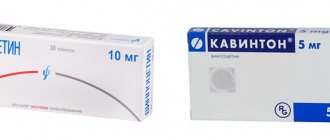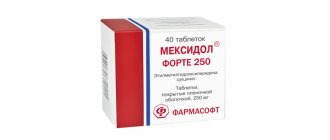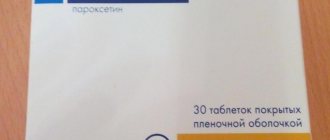Chemical composition and dosage forms
The active compound of the drug is vinpocetine. It has a vasodilator (vasodilator), antioxidant, neuroprotective effect, stimulates metabolic processes in tissues, and normalizes the rheological properties of blood.
Cavinton is produced in two pharmaceutical forms:
- Tablets: in blisters, white, with the Cavinton inscription engraved on the surface, the dosage of the active substance is 5 mg. Auxiliary components of the drug: silicon dioxide, talc, magnesium stearate, starch.
- Infusion solution in ampoules of 2 and 5 ml, used intravenously. In addition to vinpocetine, it contains distilled water, ascorbic and tartaric acids, and sorbitol.
How Cavinton works
The instructions for use of the drug inform that vinpocetine belongs to the category of cerebrovasodilating substances. It stimulates metabolism and nutrition of the brain, prevents the development of atherosclerotic lesions, improves the absorption of glucose and oxygen by cells. Cavinton helps improve the functioning of the adrenal glands, helps the exchange of norepinephrine, serotonin and other hormones.
The drug works selectively. Affects cerebral blood volume, reduces resistance of the cerebral vasculature. This process helps restore circulation in tissue areas exposed to ischemia. At the same time, the activity of the general blood circulation does not change. Heart rate and blood pressure levels remain the same after taking the medicine. The so-called reverse steal effect ensures that the affected areas remain viable. Cavinton:
- normalizes blood viscosity;
- reduces excessive platelet aggregation;
- increases cell resistance to hypoxic effects;
- slows down the penetration of adenosine into red blood cells, making them more elastic and preventing breakdown.
The drug tablets quickly dissolve in the stomach and are absorbed into the blood. The effect of the substance reaches its maximum within 1–1.5 hours. The effectiveness of injections is slightly higher. The drug does not accumulate in the body. It is excreted completely, without forming metabolites, along with feces and urine within 24 hours after administration.
Cavinton Comforte, 90 pcs., 10 mg, dispersible tablets
Vinpocetine is rapidly absorbed after oral administration and reaches its maximum blood concentration (Cmax) within 1 hour. Absorption occurs mainly in the proximal intestine. It is not metabolized when passing through the intestinal wall.
In preclinical studies of oral administration of radiolabeled vinpocetine, it was detected in the highest concentrations in the liver and gastrointestinal tract. The maximum concentration in tissues is observed 2–4 hours after oral administration.
The amount of radioactive isotope in the brain did not exceed that in the blood. Connection with proteins in the human body - 66%. The volume of distribution is 246.7 ± 88.5 l, indicating significant tissue binding. Bioavailability when taken orally - 7%. Clearance is 66.7%, which exceeds the total plasma volume of the liver (50 l/h) and indicates extrahepatic metabolism.
With repeated oral doses of 5 mg and 10 mg, the kinetics are linear; while the equilibrium concentrations in blood plasma were 1.2±0.27 ng/ml and 2.1±0.33 ng/ml, respectively. The half-life in humans is 4.83 ± 1.29 hours. In studies with a radioactively labeled drug, it was found that the main routes of elimination are excretion through the kidneys and through the intestines in a ratio of 3:2. In preclinical studies, the greatest radioactivity was detected in bile, but no evidence of significant enterohepatic circulation was found. Apovinamic acid is excreted by the kidneys by simple glomerular filtration; the half-life depends on the dose taken and the route of administration of vinpocetine.
The main metabolite of vinpocetine is apovincamic acid (AVA), the proportion of which in humans is 25–30%. After oral administration of vinpocetine, the area under the concentration-time curve of VKA is 2 times greater than that after intravenous administration. This indicates that VKA is formed during the first pass metabolism of vinpocetine. Other known metabolites are hydroxyvinpocetine, hydroxy-AVA, dihydroxy-AVA-glycinate, and their conjugates with glucuronides and/or sulfates. Vinpocetine is excreted unchanged in small quantities.
An important and useful characteristic of vinpocetine is the absence of the need for dose adjustment in diseases of the liver and kidneys due to the lack of cumulation due to the peculiarities of its metabolism.
Pharmacokinetics in special groups of patients (age, concomitant diseases):
It was revealed that the pharmacokinetics of vinpocetine in elderly patients does not differ significantly from that in young patients; there is no accumulation of the drug. Therefore, vinpocetine can be prescribed to patients with impaired liver and kidney function for a long time and in normal doses.
What is Cavinton used for?
The drug eliminates vascular damage, restores blood circulation, microcirculation and normal metabolism in various locations. Therefore, the list of his indications is extensive.
Neurological disorders:
- vertebrobasilar insufficiency of cerebral vessels;
- post-stroke condition: as part of complex treatment;
- transient ischemic attacks;
- vascular dementia;
- encephalopathy after traumatic brain injury, as a result of hypertension;
- damage to various parts of the brain associated with disruption of their nutrition and blood supply;
- memory impairment, mental disorders;
- movement coordination disorders;
- headache.
In ophthalmology, Cavinton is used to relieve vascular disorders that have caused deterioration of vision and the development of degenerative processes:
- with vasospasm, dystrophy of the retina of the fundus of the eye;
- atherosclerotic changes in capillaries;
- with secondary glaucoma;
- for diabetic eye lesions;
- with thrombosis and embolic processes.
In otolaryngology, Cavinton is used for hearing impairment and lesions of the vestibular apparatus:
- age-related dizziness;
- Meniere's disease;
- hearing loss;
- motion sickness syndrome;
- tinnitus;
- cochleovestibular neuritis;
- complications caused by inflammation of the middle ear;
- various vasovegetative pathologies.
PsyAndNeuro.ru
Cavinton, aka Vincamine, aka Oxybral, aka lesser periwinkle alkaloids, aka Vinpocetine according to the INN. Produced mainly in Hungary by Gedeon Richter and included in the Vital and Essential Drugs [1][2][3][4][5][6][7][8][9][10], but not always[11 ][12].
According to RLS, Cavinton is a neuro- and angioprotective drug, and it is used to combat dementia, stroke, atherosclerosis, encephalopathy, retinopathy, headache, etc. [13]. The mechanism of action is unknown. There is also no evidence of its effectiveness, unlike, by the way, evidence of ineffectiveness: the drug turned out to be useless for dementia [14] and stroke [15]. In 2016, the FDA stopped considering Cavinton even as a dietary supplement (this does not mean that it began to be considered a medicine in the USA; the FDA still considers Cavinton absolutely useless) [16]. RXlist believes that Cavinton's effectiveness in treating stroke, dizziness, preventing Alzheimer's disease, improving memory and treating macular degeneration is insufficient [17]. Pubmed is flooded with publications that no one needs.
So, according to these data, Cavintom is an absolutely useless drug for all diseases and there is no need to prescribe it, except as an imitation of treatment.
Well, for dessert, according to the resolution of the formulary committee of the Russian Academy of Medical Sciences, on March 16, 2007, Cavinton was recognized as an outdated drug with unproven effectiveness [18], which, by the way, did not prevent it from entering the Vital and Essential Medicines list in 2008, as in general is now preventing pharmacies and departments from purchasing millions of rubles (hospitals in general cannot afford more than 1 million rubles to purchase Cavinton) [19][20]. The purchase of the “Purchasing Agency for the Moscow City Health Department” for 44 million rubles looks especially impressive.[21]
Against this background, the code of ethics of the Gedeon Richter company looks interesting. It is especially interesting to read about high ethical standards in relation to patients [22]. Meanwhile, Wikipedia generally reports that Gedeon Richter considers it its duty to promote the development of the Russian pharmaceutical industry [23].
Author: Korovin A.S.
Sources:
- https://grls.rosminzdrav.ru/Grls_View_vaspx?routingGuid=1c3cd79b-eeb5-4f68-98f7-97af344860e6&t=
- https://grls.rosminzdrav.ru/Grls_View_vaspx?routingGuid=c8f26bc7-9790-4807-9306-c440b807489b&t=
- https://grls.rosminzdrav.ru/Grls_View_vaspx?routingGuid=4cb08aef-dcd3-4667-83b1-f846ba4c286c&t=
- https://grls.rosminzdrav.ru/Grls_View_vaspx?routingGuid=079ba40b-d595-4f3e-bd89-d8cf0470b40a&t=
- https://grls.rosminzdrav.ru/Grls_View_vaspx?routingGuid=296f9f44-b506-4c70-aed6-1f6cd668316e&t=
- https://grls.rosminzdrav.ru/Grls_View_vaspx?routingGuid=45799072-7e1e-4b18-8ab7-3fe8695184be&t=
- https://grls.rosminzdrav.ru/Grls_View_vaspx?routingGuid=b108571f-a3ac-44aa-87f2-5fa26e4e5fd9&t=
- https://grls.rosminzdrav.ru/Grls_View_vaspx?routingGuid=4d565781-20fd-4a26-bbca-60b4f726fecc&t=
- https://grls.rosminzdrav.ru/Grls_View_vaspx?routingGuid=bf69b798-b1f7-4faa-8383-f74f51c71e63&t=
- https://grls.rosminzdrav.ru/Grls_View_vaspx?routingGuid=d65dd305-8612-4708-8665-bb5588d02965&t=
- https://grls.rosminzdrav.ru/Grls_View_vaspx?routingGuid=2622c283-e4ab-4e36-8f36-57fd1cb5a539&t=
- https://grls.rosminzdrav.ru/Grls_View_vaspx?routingGuid=4024325e-01cf-4d92-b66a-d78f611dc72b&t=
- https://www.rlsnet.ru/tn_index_idhtm
- https://www.cochranelibrary.com/cdsr/doi/10.1002/14651858.CD003119/abstract
- https://www.cochranelibrary.com/cdsr/doi/10.1002/14651858.CD000480/abstract
- https://www.fda.gov/Food/DietarySupplements/ProductsIngredients/ucmhtm
- https://www.rxlist.com/vinpocetine/supplements.htm
- https://www.rspor.ru/mods/news/docs/Resolution_Formulary_committee_meeting03.%202007.doc
- https://www.zakupki.gov.ru/epz/order/extendedsearch/results.html?searchString=%D0%BA%D0%B0%D0%B2%D0%B8%D0%BD%D1%82%D0 %BE%D0%BD&morphology=on&pageNumber=1&sortDirection=false&recordsPerPage=_10&showLotsInfoHidden=false&fz44=on&fz223=on&ppRf615=on&af=true&ca=true&pc=true&pa=true¤cyIdGeneral=-1®ionDeleted=false&sortB y=PRICE&openMode=USE_DEFAULT_PARAMS
- https://www.zakupki.gov.ru/epz/order/extendedsearch/results.html?searchString=%D0%92%D0%B8%D0%BD%D0%BF%D0%BE%D1%86%D0 %B5%D1%82%D0%B8%D0%BD&morphology=on&pageNumber=1&sortDirection=false&recordsPerPage=_10&showLotsInfoHidden=false&fz44=on&fz223=on&ppRf615=on&selectedSubjects=&af=true&ca=true&pc=true&pa=true& priceFromGeneral=&priceToGeneral=&priceFromGWS=&priceToGWS=&priceFromUnitGWS=&priceToUnitGWS =¤cyIdGeneral=-1®ions=®ionDeleted=false&sortBy=PRICE&openMode=USE_DEFAULT_PARAMS
- https://www.zakupki.gov.ru/epz/order/notice/ea44/view/common-info.html?regNumber=0873200009816002327
- https://www.g-richter.ru/about/GR_today/
- https://ru.wikipedia.org/wiki/Gedeon_Richter
How to use Cavinton correctly: instructions
The medication is approved for patients over 18 years of age. Treatment with the drug in tablets requires long-term administration. The full course ranges from 1 to 8 months, depending on the type of disease. On average, to achieve pronounced results, Cavinton is taken for 3–4 months in a row:
- 1 tab. three times a day, without chewing;
- You need to take the medicine with a large volume of water;
- time of administration: 1–1.5 hours after meals.
The infusion drug must be administered intravenously: through a syringe or through droppers. Intramuscular use of the product is prohibited.
- Before use, Cavinton is diluted in saline solution at the rate of: 20 ml of concentrate per 500 ml of liquid;
- the prepared solution is suitable for use within 3 hours;
- therapy is carried out by administering 80 drops of the drug per minute.
The exact treatment regimen is formed by the doctor, taking into account the indications and general condition of the patient’s body. Cavinton should be discontinued gradually, gradually reducing the dosage over 3–5 days.
The medicine does not have a toxic effect on the kidneys and liver. It should be used with caution in case of hemorrhagic stroke: no earlier than 7 days after the attack.
Use of the drug Cavinton tablets
Usually 1 tablet (5 mg) 3 times a day. The course of treatment is 1–8 months, on average 3–4 months. If the drug is discontinued, the dose of Cavinton is reduced gradually over 2-3 days. In the acute period of the disease, it is recommended to begin treatment with parenteral administration of the drug. After completing the course of infusion therapy, treatment with Cavinton is recommended to be continued orally at a dose of 1–2 tablets (5–10 mg) 3 times a day after meals. Due to Cavinton's lack of hepato- and nephrotoxic effects, there is no need for dose adjustment in patients with kidney or liver diseases.
When is Cavinton contraindicated?
Contraindications include:
- children's age: up to 18 years, the vascular system is imperfect;
- during pregnancy and lactation: due to the insufficiently studied effect of the drug on the body of the fetus and newborns;
- lactose intolerance;
- severe heart damage accompanied by arrhythmia;
- hypersensitivity to the components of the drug.
Cavinton is prohibited from being used in conjunction with heparin preparations due to the risk of a sharp decrease in blood clotting. Simultaneous intake of alcohol is also prohibited, since the active substance enhances its toxic properties.



